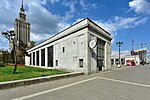Museum of Evolution of Polish Academy of Sciences
Institutes of the Polish Academy of SciencesMuseums in WarsawNatural history museums in PolandPolish museum stubs

The Museum of Evolution of Polish Academy of Sciences (Polish: Muzeum Ewolucji Instytutu Paleobiologii Polskiej Akademii Nauk) is the display area of the natural history museum in Warsaw, Poland. It is the public front of the Muzeum i Instytut Zoologii or Zoology Museum and the Instytut Paleobiologii or Paleobiology Institute. It is based at the Palace of Culture and Science.
Excerpt from the Wikipedia article Museum of Evolution of Polish Academy of Sciences (License: CC BY-SA 3.0, Authors, Images).Museum of Evolution of Polish Academy of Sciences
Plac Defilad, Warsaw Śródmieście (Warsaw)
Geographical coordinates (GPS) Address Website Nearby Places Show on map
Geographical coordinates (GPS)
| Latitude | Longitude |
|---|---|
| N 52.231666666667 ° | E 21.006388888889 ° |
Address
Pałac Kultury
Plac Defilad 1
00-110 Warsaw, Śródmieście (Warsaw)
Masovian Voivodeship, Poland
Open on Google Maps










